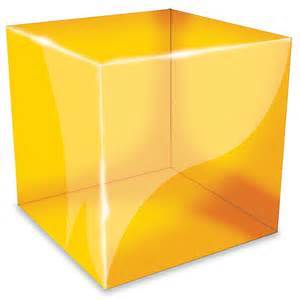The Hexahedron tri-section
Find the minimum sum total surface area of the parts of a unit volume cube that has been divided into 3 regions that all have the same area-to-volume ratio.

Give your answer to 3 decimal places.
The answer is 9.202.
This section requires Javascript.
You are seeing this because something didn't load right. We suggest you, (a) try
refreshing the page, (b) enabling javascript if it is disabled on your browser and,
finally, (c)
loading the
non-javascript version of this page
. We're sorry about the hassle.
Here's how an unit cube can be divided into 3 parts which all can have the same area-to-volume ratio. When optimized, this ratio has a minimum of approximately 9 . 2 0 1 3 9 . Since the surface area of each part is this ratio times its volume, the total surface area of all three parts is the same, 9 . 2 0 1 3 9 , in the case of an unit cube of volume 1 .
It should be noted that this is not the minimum total surface area of the plane cuts, given the volume of each of the 3 parts. That is a slightly different proposition.
Edit First consider the simpler case of dividing the unit cube into two parts with the same area-to-volume ratio, which we’ll call k . The surface area of both combined is the surface area of the unit cube, which is fixed, plus twice the surface area of the cut dividing them. The least area of such a cut is a square cross section of side length of 1 . The k for either part works out to 8 . Now consider the simplest way to divide the cube into three parts, which is to make them identical boxes. The k for any one part works out to 1 0 , and that gives a range to find the optimum for this problem, between 8 and 1 0 .
The challenge is to find any part with less volume than 2 1 that has a k less than 1 0 . Assuming only plane cuts as to minimize total surface area, we first consider a plane cut passing through only 3 adjacent faces of the cube. The largest such volume that can be cut from the cube is when the plane pass through the diagonals of the 3 faces. The k for this pyramid works out to 1 4 . 1 9 5 , and anything smaller will result in a higher k . Next, we consider a plane cut passing through 2 adjacent faces and 2 opposite faces of the cube. Again, the largest such volume that can be cut from the cube is when the plan pass through the diagonals of the 2 opposite faces. The k for this prism works out to 8 . 8 2 8 , which offers a possibility.
We then have two possible scenarios, both of them involving plane cuts perpendicular to 2 opposite faces. Three plane cuts meet at a common line which runs from one face to the opposite face, and either one plane cut begins at a corner of the cube, while the other two begins at the faces opposite to that corner, or one plane cut begins at the center line of one face, while the other two begins at the faces adjacent to the first face. It works out that the optimum k for the first scenario is 9 . 4 4 1 1 9 while for the second scenario is 9 . 2 0 1 3 9 . We will look at how the second result is derived.
Let s and t be the length of the parallel sides of the trapezoidal faces of one of the smaller parts, the s being the side common with the other. The volumes and areas of the two kinds of parts are
V 1 = 2 1 2 1 ( s + t )
A 1 = 2 2 1 2 1 ( s + t ) + ( s + 2 1 + t ) + ( 2 1 ) 2 + ( t − s ) 2
V 2 = 1 − 2 2 1 2 1 ( s + t )
A 2 = 2 ( 1 − 2 2 1 2 1 ( s + t ) ) + ( 1 + 2 ( 1 − t ) ) + 2 ( 2 1 ) 2 + ( t − s ) 2
Because of the condition that all parts must have the same k , we have
V 1 A 1 = V 2 A 2
Solving for s and t numerically, where not only k is the same for both kinds of parts, but is at a minimum, we have
s = 0 . 5 8 2 1 4
t = 0 . 6 7 8 9 0 9
resulting in k = 9 . 2 0 1 3 9
This is not a full proof that this is the minimum possible k , but space here doesn’t permit one.